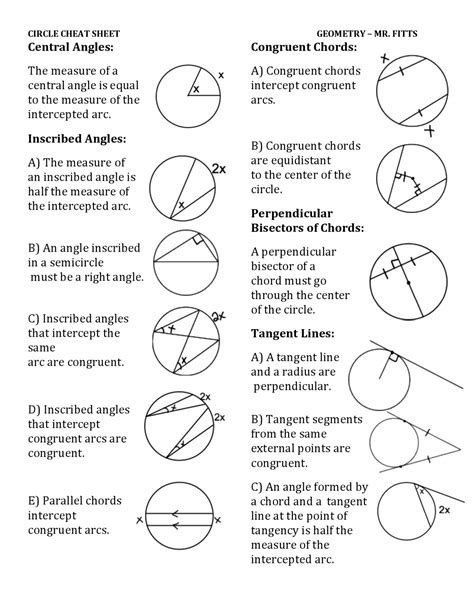Introduction

Circles, ubiquitous in our world, play a significant role in various fields, from mathematics and science to art and engineering. Understanding the properties and formulas associated with circles is crucial for effective problem-solving and decision-making. This comprehensive formula sheet provides a concise reference for essential circle-related concepts, empowering you to tackle any circular challenge with confidence.
1. Definitions
- Circle: A plane figure bounded by a curved line equidistant from a fixed point called the center.
- Radius (r): A line segment from the center to any point on the circle.
- Diameter (d): A line segment passing through the center and having both endpoints on the circle.
- Circumference (C): The total distance around the circle.
2. Formula for Circumference
C = 2πr = πd
where:
- π (pi) is an irrational number approximately equal to 3.14159.
3. Formula for Area
A = πr²
where:
- r is the radius of the circle.
4. Formula for Area of a Sector
A = (θ/360°)πr²
where:
- θ is the central angle of the sector in degrees.
5. Formula for Length of an Arc
L = (θ/360°)C
where:
- θ is the central angle of the arc in degrees.
6. Formula for Equation of a Circle
(x - h)² + (y - k)² = r²
where:
- (h, k) is the center of the circle.
- r is the radius of the circle.
7. Applications of Circles
Circles have wide-ranging applications across diverse fields:
- Architecture: Designing arches, domes, and other circular structures.
- Automotive: Creating wheels, tires, and gears.
- Biology: Modeling cells, bacteria, and DNA.
- Mathematics: Calculating perimeters, areas, and volumes of circular objects.
- Physics: Studying circular motion, centripetal force, and wave propagation.
8. Innovative Ideas
Engineer new applications for circles by leveraging their unique properties:
- Circular Aerodynamics: Utilizing curved surfaces for aerodynamic efficiency in vehicles and aircraft.
- Circular Energy: Harnesses the shape of circles for efficient energy storage and transmission.
- Circular Computing: Exploring the potential of circular data flow and interconnected networks.
- Circular Design: Embracing circular shapes in architecture, interior design, and product development.
9. Tables
Table 1: Unit Circle Conversions
| Degrees | Radians |
|---|---|
| 0° | 0 |
| 30° | π/6 |
| 45° | π/4 |
| 60° | π/3 |
| 90° | π/2 |
| 180° | π |
| 360° | 2π |
Table 2: Circle Properties
| Property | Formula |
|---|---|
| Circumference | C = 2πr |
| Area | A = πr² |
| Radius | r = d/2 |
| Diameter | d = 2r |
Table 3: Arc and Sector Properties
| Property | Formula |
|---|---|
| Length of Arc | L = (θ/360°)C |
| Area of Sector | A = (θ/360°)πr² |
Table 4: Equation of a Circle
| Center | Equation |
|---|---|
| (0, 0) | x² + y² = r² |
| (h, k) | (x – h)² + (y – k)² = r² |
Conclusion
This comprehensive formula sheet serves as an invaluable resource for understanding and working with circles in various contexts. By utilizing these formulas and exploring innovative applications, you can effectively solve problems, optimize designs, and make informed decisions involving circular shapes. Embrace the power of circles and unlock their endless possibilities!
